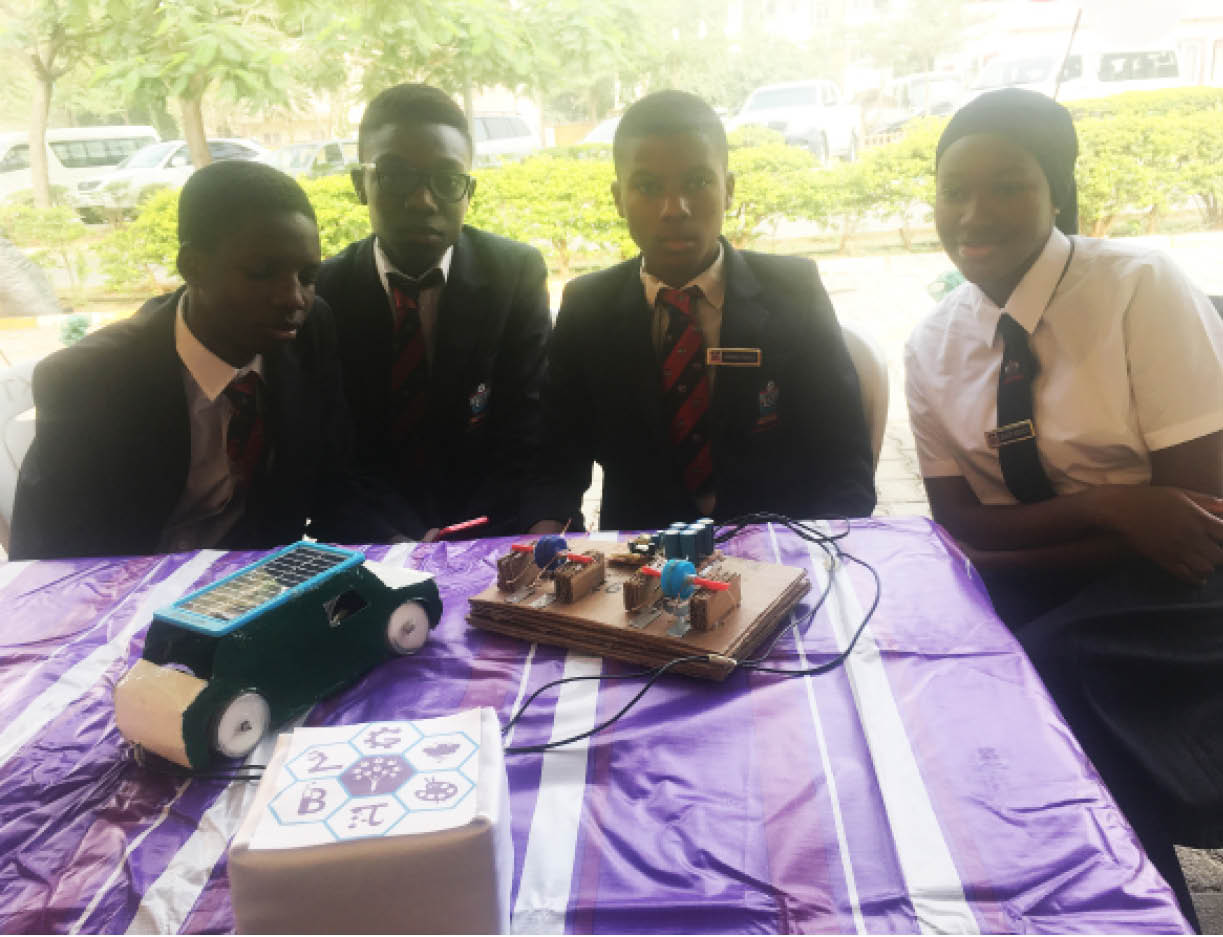Day science, art fair showcased children’s inventiveness in Abuja
On February 26, students from secondary schools exhibited innovative projects during a science and art fair organized by Nigerian Tulip International Colleges (NTIC), Abuja. Daily Trust’s Art & Ideas was there. Coordinated by Mr. Isaiah Ugbede Onekutu, Nigerian Tulip International Colleges (NTIC) Art and Science Fair brought together young innovators to create. Some, like […]

Students pose before a remote controlled hybrid car they made
On February 26, students from secondary schools exhibited innovative projects during a science and art fair organized by Nigerian Tulip International Colleges (NTIC), Abuja. Daily Trust’s Art & Ideas was there.
Coordinated by Mr. Isaiah Ugbede Onekutu, Nigerian Tulip International Colleges (NTIC) Art and Science Fair brought together young innovators to create. Some, like Stephanie Idoko, a 15-year-old, worked on projects triggered by their environment.
Fuel generation
Idoko’s concept, called ‘pyrolysis,’ was inspired by the high number of plastic waste in Nigeria. So, she decided to invent a process of recycling that can produce fuel. “My project is a form of thermal degradation that converts waste materials such as plastics into fuel,” she said, adding that it is better than extracting from the ground which leaves the environment in ruin. This method, she stressed, will provide jobs for every category of people. For instance, while the educated work on the chemical process, others work on collecting plastics, cleaning them and placing them in the heating vessels to get the oil.
But how was Idoko able to achieve this? She compressed plastics in her heating vessel, which melted the waste materials. “The plastics condense and flow through the delivery tube into different containers,” she said. “The dense materials are collected into a separate container while the less dense materials are collected into another container; the much lighter ones are collected in a balloon, which can combust.”
Hybrid car
A team that includes Udechukwu Prestige, Sadiq Khadija, Godstime Ehrikanwem and Ekemili Abassey built what they call ‘a remote-control hybrid car’ that can work on renewable energy to curb harmful emission in the environment. It is focused on reducing climate change in the society. They said it works with a solar panel to generate power stored in capacitors which charges a lot faster and is able to produce voltage. As long as current enters the solar panel, the car keeps working.
Molt ball experiment
A Senior Secondary Two student, Hafeez Alemaroff, did an experiment he calls ‘Educated molt ball experiment’ that attempts to debunk the theory of floating and sinking. He said that people are of the idea that when an object has density, it sinks, but when it does not, it floats. “My experiment is telling the society that regardless of whether a substance is denser than water, it still has the ability to float.
“On a normal day, when you put naphthalene balls into water, it sinks, but here, it floats. The reason is that when you add HCL and sodium carbonate, they give you C02, a gas that makes naphthalene lose weight in water, thereby giving it the ability to float. Whenever the gas goes down, the balls go down.”
Puzzle game, farming solution
Hooriya Ahmed and Suheyla Gulsum Akyuz made a Chinese metal ring puzzle game played by finding a way to detangle metals joined together. This puzzle, they said, exercises your brain and finger muscles and cultivates the spirit of patience.
The duo of Nuru Alhassan (JSS1) and Faruk Auwal (SS1) invented an integrated cultivation system that can solve the problem of farming in polluted lands in the Niger Delta.
Others, like Nadia Animashaun and Naim Hassan, worked on projects related to Physical Geography. “We keep destroying forests. I just wanted to show that there is beauty in what God has created,” Animashaun said and suggested that green houses and more zoos should be provided in order to preserve nature. “If we keep destroying these things, we may end up dead sooner than imagined because there wouldn’t be plants and animals to give us oxygen.
Water level detector
Arafat Abubakar and Habiba Ajibade used water as a source of energy for what they call ‘water level detector.’ They said: “The water level detector is used to alert us when our water tanks are filled up or its level.” Some components of their invention are six transistors, six LED light and two buzzers. The resistors help reduce the amount of voltage that goes into the light bulb to stop the light bulb from bursting. The transistor is made up of three parts, the base, the emitter and the collector. The base sends signals to the collector to power up the light.
Alongside his grandfather, Sa’id Jamal, a primary four pupil alongside his grandfather, built a marine house aeroplane model which has a dispatch house, a store, and table tennis court. “It was built because my grandmother loves to travel,” Jamal said.
Coordinator of the NTIC Science and Art Fair, Mr. Onekutu, encouraged schools and corporate bodies to organise fairs where young innovators can have a platform to grow. He added that government should ensure schools run such programs in order to build the minds of students beyond the confines of their schools.
